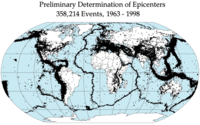
Photo from wikipedia
Abstract On asteroids, impact-induced seismic shaking is an important geological process related to the modifications of the surface features that are due to the movement of regolith grains on the… Click to show full abstract
Abstract On asteroids, impact-induced seismic shaking is an important geological process related to the modifications of the surface features that are due to the movement of regolith grains on the asteroid surface. Mass movements caused by seismic shaking (e.g., landslides and crater erasures) were recently observed by several spacecrafts. To elucidate the seismic shaking areas induced by impacts on asteroids, it is necessary to determine the excitation and the decay processes of impact-induced seismic waves. Here we conducted impact cratering experiments using 500-μm quartz sand to simulate an asteroid surface at the Institute of Space and Astronautical Science (ISAS), Japan Aerospace Exploration Agency (JAXA). We used 4.75-mm- and 2-mm-diameter projectiles with density from 14.9 to 1.2 g cm−3; the impact velocity ranged from 7 to 0.2 km s−1. We measured the acceleration waveform by using three to five accelerometers setting on the target surface, and we examined three parameters characterizing the impact-induced seismic wave with varying distances from the impact point: the propagation velocity (Vprop), the maximum acceleration (gmax), and the half period of the first upward peak (Thalf). The Vprop was obtained to be 52.4 ± 7.2 m s−1, regardless of the impact velocity and the projectile properties, and the Thalf slightly depended on the impact velocity as v i 0.14 but was independent of the projectile properties. The gmax had a close relationship with the distance from the impact point normalized by the crater rim radius, x/Rrim, regardless of the impact velocity and the projectile properties. The obtained empirical equation was shown as gmax = 102.21(x/Rrim)−3.18. By using the empirical equations we obtained herein, we observed that the seismic energy normalized by the kinetic energy of a projectile, Es/Ek, decreased with the increase of the normalized distance, x/Rrim. We also estimated the area of impact-induced seismic shaking on an idealized small (500 m in diameter) body at the impact velocity of 5 km s−1.
Journal Title: Icarus
Year Published: 2020
Link to full text (if available)
Share on Social Media: Sign Up to like & get
recommendations!